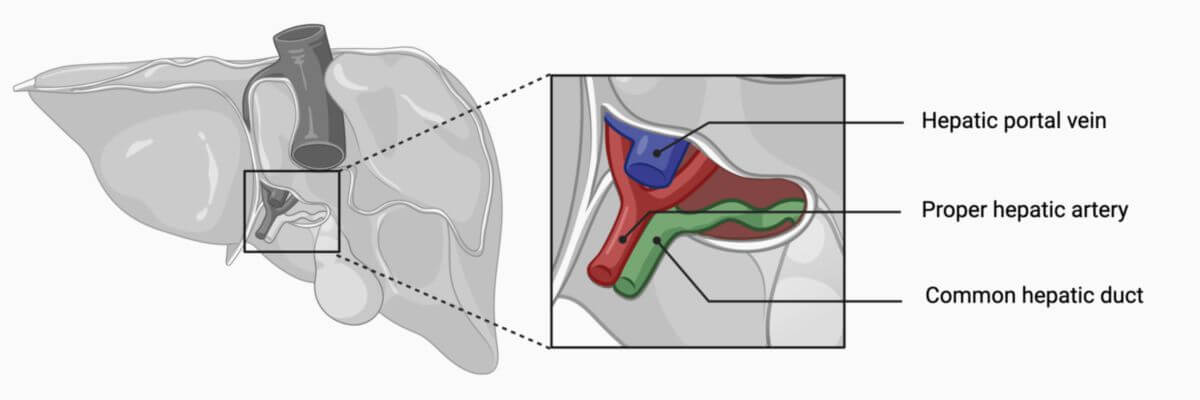Corpus: Hepatic portal vein: Unterschied zwischen den Versionen
(Englische Seite angelegt) |
KKeine Bearbeitungszusammenfassung |
||
| (Eine dazwischenliegende Version von einem anderen Benutzer wird nicht angezeigt) | |||
| Zeile 1: | Zeile 1: | ||
==Definition== | ==Definition== | ||
The ''' | The '''hepatic portal vein''' is a large [[Corpus:Blood vessel|vessel]] that carries oxygen-poor but nutrient-rich blood from the [[Corpus:Digestive organs|digestive organs]] to the [[Corpus:Liver|liver]]. | ||
==Course== | ==Course== | ||
The portal vein is located behind the [[Corpus:Pancreas|pancreas]] and travels with the [[Corpus:Common hepatic artery|hepatic artery]] in the [[Corpus:Hepatoduodenal ligament|hepatoduodenal ligament]] toward the [[Corpus:Porta hepatis|porta hepatis]] | The hepatic portal vein is located behind the [[Corpus:Pancreas|pancreas]] and travels with the [[Corpus:Common hepatic artery|hepatic artery]] in the [[Corpus:Hepatoduodenal ligament|hepatoduodenal ligament]] toward the [[Corpus:Porta hepatis|porta hepatis]]. It forms from the union of the [[Corpus:Superior mesenteric vein|superior mesenteric vein]] and the [[Corpus:Splenic vein|splenic vein]], a convergence known as the confluence. Other tributary veins also join the portal vein along its course. | ||
<dcembed ratio=" | <dcembed ratio="3x2"><dcEmbedUrl src="https://www.doccheck.com/de/detail/photos/43637-porta-hepatis"></dcEmbedUrl></dcembed> | ||
Once it enters the liver, the portal vein splits into two branches, each serving the | Once it enters the liver, the hepatic portal vein splits into two branches, each serving the right and left lobes of the liver. From there, it further divides into smaller branches that end in the [[Corpus:Hepatic sinusoid|hepatic sinusoids]]. | ||
==Tributaries== | ==Tributaries== | ||
* [[Corpus:Right gastric vein|Right gastric vein]] | * [[Corpus:Right gastric vein|Right gastric vein]] (from the [[Corpus:Stomach|stomach]]) | ||
* [[Corpus:Left gastric vein|Left gastric vein]] | * [[Corpus:Left gastric vein|Left gastric vein]] (from the stomach) | ||
* [[Corpus:Pyloric vein|Pyloric vein]] | * [[Corpus:Pyloric vein|Pyloric vein]] (from the [[Corpus:Pylorus|pylorus]]) | ||
* Superior mesenteric vein | * [[Corpus:Superior mesenteric vein|Superior mesenteric vein]] (from the [[Corpus:Small intestine|small intestine]]) | ||
* [[Corpus:Inferior mesenteric vein|Inferior mesenteric vein]] | * [[Corpus:Inferior mesenteric vein|Inferior mesenteric vein]] (from the [[Corpus:Colon|colon]], flows into the [[splenic vein]]) | ||
* Splenic vein | * Splenic vein (from the [[Corpus:Spleen|spleen]]) | ||
Other smaller tributaries include the [[Corpus:Cystic vein|cystic vein]] (from the [[Corpus:Gallbladder|gallbladder]]) and the [[Corpus:Paraumbilical vein|paraumbilical veins]]. | |||
==Physiology== | ==Physiology== | ||
The portal vein is essential for transporting nutrient-rich blood from the [[gastrointestinal tract]] to the liver for processing. The liver metabolizes nutrients and detoxifies substances, ensuring that any absorbed toxins (such as | The hepatic portal vein is essential for transporting nutrient-rich blood from the [[gastrointestinal tract]] to the liver for processing. The liver metabolizes nutrients and detoxifies substances, ensuring that any absorbed toxins (such as ammonia) are processed before entering the systemic circulation. This system of blood flow is known as portal circulation'''.''' | ||
== | ==Clinic== | ||
Key pathological conditions affecting the portal vein include: | Key pathological conditions affecting the portal vein include: | ||
* Portal vein thrombosis | * Portal vein thrombosis | ||
* Portal hypertension | * Portal hypertension | ||
[[Kategorie:Corpus]] | [[Kategorie:Corpus]] | ||
[[Kategorie:Vein]] | [[Kategorie:Vein]] | ||
[[Kategorie:Liver]] | [[Kategorie:Liver]] | ||
Aktuelle Version vom 18. September 2024, 10:11 Uhr
Definition
The hepatic portal vein is a large vessel that carries oxygen-poor but nutrient-rich blood from the digestive organs to the liver.
Course
The hepatic portal vein is located behind the pancreas and travels with the hepatic artery in the hepatoduodenal ligament toward the porta hepatis. It forms from the union of the superior mesenteric vein and the splenic vein, a convergence known as the confluence. Other tributary veins also join the portal vein along its course.
Once it enters the liver, the hepatic portal vein splits into two branches, each serving the right and left lobes of the liver. From there, it further divides into smaller branches that end in the hepatic sinusoids.
Tributaries
- Right gastric vein (from the stomach)
- Left gastric vein (from the stomach)
- Pyloric vein (from the pylorus)
- Superior mesenteric vein (from the small intestine)
- Inferior mesenteric vein (from the colon, flows into the splenic vein)
- Splenic vein (from the spleen)
Other smaller tributaries include the cystic vein (from the gallbladder) and the paraumbilical veins.
Physiology
The hepatic portal vein is essential for transporting nutrient-rich blood from the gastrointestinal tract to the liver for processing. The liver metabolizes nutrients and detoxifies substances, ensuring that any absorbed toxins (such as ammonia) are processed before entering the systemic circulation. This system of blood flow is known as portal circulation.
Clinic
Key pathological conditions affecting the portal vein include:
- Portal vein thrombosis
- Portal hypertension

